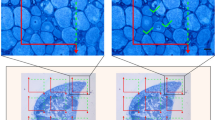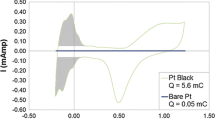Abstract
Acute damage to axons is manifested as a breach in their membranes, ion exchange across the compromised region, local depolarization, and sometimes conduction block. This condition can worsen leading to axotomy. Using a novel recording chamber, we demonstrate immediate arrest of this process by application of polyethylene glycol (PEG) to a severe compression of guinea pig spinal cord. Variable magnitudes of compound actions potentials (CAPs) were rapidly restored in 100% of the PEG-treated spinal cords. Using a dye exclusion test, in which horseradish peroxidase is imbibed by damaged axons, we have shown that the physiological recovery produced by polyethylene glycol was associated with sealing of compromised axolemmas. Injured axons readily imbibe horseradish peroxidase—but not following sealing of their membranes. The density of nerve fibers taking up the marker is significantly reduced following polyethylene glycol treatment compared to a control group. We further show that all axons—independent of their caliber—are equally susceptible to the compression injury and equally susceptible to polyethylene glycol mediated repair. Thus, polyethylene glycol—induced reversal of permeabilization by rapid membrane sealing is likely the basis for physiological recovery in crushed spinal cords. We discuss the clinical importance of these findings.
Similar content being viewed by others
References
AHKONG, Q. F., DESMAZES, J. P., GEORGESCAULD, D. & LUCY, J. A. (1987) Movements of fluorescent probes in the mechanism of cell fusion induced by polyethylene glycol. Journal of Cell Science 88, 389–98.
ASANO, T., SHI, R. & BLIGHT, A. R. (1995) Horseradish proxidase used to examine the distribution of axonal damage in spinal cord compression injury in vitro. Journal of Neurotrauma 12, 993, Abstract.
BLIGHT, A. R., MCGINNIS, M. E. & BORGENS, R. B. (1990) Cutaneus trunci muscle reflex of the guinea pig. Journal of Comparative Neurology 296, 614–633.
BORGENS, R. B., BLIGHT, A. R. & MURPHY, D. J. (1986) Axonal regeneration in spinal cord injury: A perspective and new technique. Journal of Comparative Neurology 250, 157–167.
BORGENS, R. B., TOOMBS, J. P., BLIGHT, A. R., MCGINNIS, M. E., BAUER, M. S., WIDMER, W. R. & COOK, J. R. Jr. (1993) Effects of applied electric fields on clinical cases of complete paraplegia in dogs. J. Restorative Neurology and Neurosci. 5, 305–322.
BORGENS, R. B. & SHI, R. (2000) Immediate recovery from spinal cord injury through molecular repair of nerve membranes with polyethylene glycol. FASEB Journal 14, 27–35.
BORGENS, R. B., TOOMBS, J. P., BREUR, G., WIDMER, W. R., WATER, D., HARBATH, A. M., MARCH, P. & ADAMS, L. G. (1999) An imposed oscillating electrical field improves the recovery of function in neurologically complete paraplegic dogs. Journal of Neurotrama 16, 639–657.
DAVIDSON, R. L., O'MALLEY, K. A. & WHEELER, T. B. (1976) Induction of mammalian somatic cell hybridization by polyethylene glycol. Somatic Cell and Molecular Genetics 2, 271–280.
DIMITRIJEVIC, M. R. (1995) Clinical aspects of traumatic injury to central nervous system axons. In The Axon (edited by WAXMAN, S. G., KOCSIS, J. D. & STYS, P. K.) pp. 669–679. New York: Oxford UP.
FEHLINGS, M. & TATOR, C. (1995) The relationships among the severity of spinal cord injury, residual neurological function, axon counts, and counts of retrogradely labeled neurons after experimental spinal cord injury. Experimental Neurology 132, 123–134.
GRIFFIN, J. W., GEORGE, E. B., HSIEH, S. & GLASS, J. D. (1995) Axonal degeneration and disorders of the axonal cytoskeleton. In The Axon (edited by WAXMAN, S. G., KOCSIS, J. D. & STYS, P. K.) pp. 375–390. New York: Oxford UP.
GUTH, L. (1969) Trophic effects of vertebrate neurons. Neuroscience Research Program Bulletin 7, 1–73.
HANNIG, J., YU, J., BECKETT, M., WEICHSELBAUM, R. & LEE, R. C. (1999) Poloxamine 1107 sealing of radiopermeabilized erythrocyte membranes. International Journal of Radiation Biology 75, 379–385.
HONMOU, O. & YOUNG, W. (1995) Traumatic injury to the spinal axons. In The Axon (edited by WAXMAN, S. G., KOCSIS, J. D. & STYS, P. K), pp. 480–503. New York: Oxford UP.
LEE, J. & LENTZ, B. R. (1997) Evolution of lipid structures during model membrane fusion and the relation of this process to cell membrane fusion. Biochemistry 36, 6251–6259.
LENTZ, B. R. (1994) Induced membrane fusion; Potential mechanism and relation to cell fusion events. Chemistry and Physics of Lipids 73, 91–106.
MALMGREN, L. & OLSSON, L. (1977) A sensitive histochemical method for light and electron microscopic demonstration of horseradish peroxidase. Journal of Histochemistry and Cytochemistry 25, 1280–1283.
MAXWELL, W. L. (1996) Histopathological changes at central nodes of ranvier after stretch-injury. Microscopy Research and Technique 34, 522–535.
MAXWELL, W. L. & GRAHAM, D. I. (1997) Loss of axonal microtubules and neurofilaments after stretch-injury to guinea pig optic nerve fibers. Journal of Neurotrauma 14, 603–614.
MAXWELL, W. L., WATT, C., GRAHAM, D. I. & GENNARELLI, T. A. (1993) Ultrastructural evidence of axonal shearing as a result of lateral acceleration of the head in non-human primates. Acta Neuropathologica 86, 136–144.
MORIARTY, L. J., DUERSTOCK, B. S., BAJAJ, C. L., LIN, K. & BORGENS, R. B. (1998) Two and three dimensional computer graphic evaluation of the subacute spinal cord injury. Journal of The Neurological Sciences 155, 121–137.
NAKAJIMA, N. & IKADA, Y. (1994) Fusogenic activity of various water-soluble polymers. Journal of Biomaterials Science, Polymer Edition 6, 751–9.
O'LAGUE, P. H. & HUNTTER, S. L. (1980) Physiological and morphological studies of rat pheochromocytoma cells (PC12) chemically fused and grown in culture. Proceedings of the National Academy of Sciences USA 77, 1701–1705.
PADANLAM, J. T., BISCHOF, J. C., CRAVALHO, E. G., TOMPKINS, R. G., YARMUSH, M. L. & TONER, M. (1994) Effectiveness of Poloxamer 188 in arresting calcein leakage from thermally damaged isolated skeletal muscle cells. Annals of the New York Academy of Sciences 92, 111–123.
PALMER, J. S., CROMIE, W. J. & LEE, R. C. (1998) Surfactant administration reduces testicular ischemiareprefusion injury. Journal of Urology 159, 2136–2139.
SHI, R., ASANO, T. & BLIGHT, A. R. (1996) Sucrose gap recording of membranes resealing in mammalian spinal cord axons. Society for Neuroscience Abstracts 22, 1185.
SHI, R. & BLIGHT, A. R. (1996) Compression injury of mammalian spinal cord in vitro and the dynamics of action potential conduction failure. Journal of Neurophysiology 76, 1572–1580.
SHI, R., ASANO, T., VINING, N. C. & BLIGHT, A. R. (1997) m-Calpain dependence of membrane sealing in mammalian spinal cord axons. Society for Neuroscience Abstracts 108, 16.
SHI, R. & BLIGHT, A. R. (1997) Differential effects of low and high concentrations of 4-Aminopyridine on axonal conduction in normal and injured spinal cord. Neuroscience 77, 553–562.
SHI, R. & BORGENS, R. B. (1999) Acute repair of crushed guinea pig spinal cord by polyethylene glycol. Journal of Neurophysiology 81, 2406–2414.
SHI, R., BORGENS, R. B. & BLIGHT, A. R. (1999) Functional reconnection of severed mammalian spinal cord axons with polyethylene glycol. Journal of Neurotrauma 16, 727–738.
XIE, X. & BARRETT, J. N. (1991) Membrane resealing in cultured rat septal neurons after neurite transection: evidence for enhancement by Ca2+-triggered protease activity and cytoskeletal disassembly. Journal of Neuroscience 11, 3257–3267.
YAWO, H. & KUNO, M. (1985) Calcium dependence of membrane sealing at the cut end of the cockroach giant axon. Journal of Neuroscience 5, 1626–1632.
Author information
Authors and Affiliations
Rights and permissions
About this article
Cite this article
Shi, R., Borgens, R.B. Anatomical repair of nerve membranes in crushed mammalian spinal cord with polyethylene glycol. J Neurocytol 29, 633–643 (2000). https://doi.org/10.1023/A:1010879219775
Issue Date:
DOI: https://doi.org/10.1023/A:1010879219775




